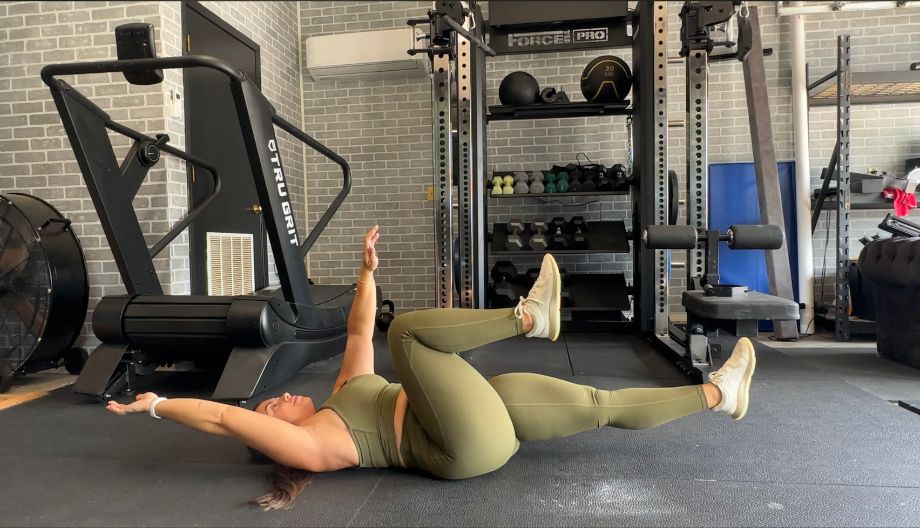We test and review fitness products based on an independent, multi-point methodology. If you use our links to purchase something, we may earn a commission. Read our disclosures.
It’s funny how a lot of movements we mastered as children, like squatting, lunge exercises, crawling, and jumping, to name a few, make such great exercises.
Take the dead bug exercise for example.
Simply lying on your back with your legs in the air like, well, a dead bug, provides a variety of benefits. You’ll receive great activation to your core1, including abdominal muscles like the rectus abdominis, transverse abdominis, and obliques, as well as the erector spinae, multifidus, hip flexors, and pelvic floor, making it one of the all-around best ab exercises for building core strength and stability.
It’s also excellent for preventing and reducing low back pain2, which is great considering lower back pain has historically been the leading cause of disability3 affecting more than an estimated half a billion people worldwide.
Are you ready to add the dead bug exercise into your ab workout routine?
Here are step-by-step instructions on how to do the dead bug exercise, including tips from a personal trainer for proper form, common mistakes to avoid, some useful gear recommendations, and other insightful info.
How To Do the Dead Bug Exercise
- Lie face up on the floor with your knees forming a 90-degree angle above your hips and your arms fully extended above your chest.
- Brace your core, pushing your lower back into the mat.
- Extend your right hand above your head and your left leg in front of you.
- Return to the starting position and repeat for the left arm and right leg.
- Alternate sides until the set is complete.
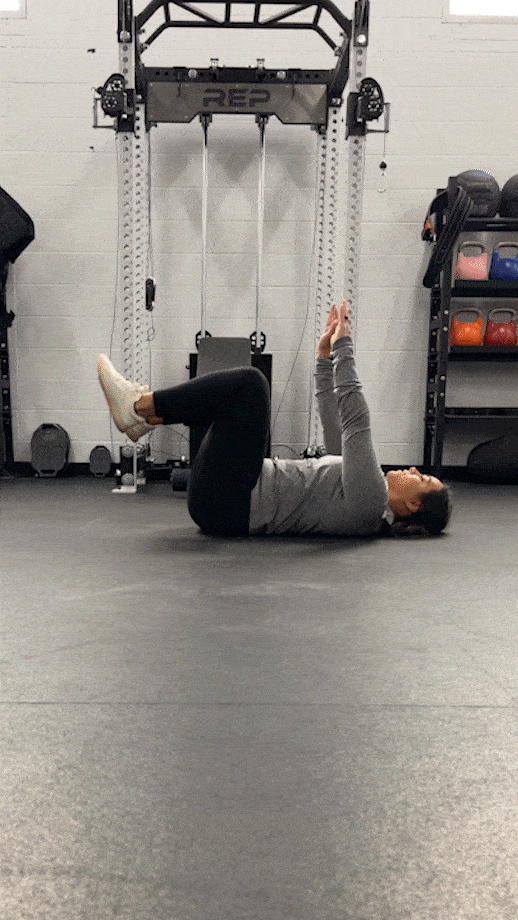
Trainer Tips for Form
The dead bug is a fantastic full-body core move, but you’ll need to perform it with proper form if you want to reap the rewards of this lower body stability exercise. Here are tips from our GGR experts on how to nail it.
Maintain a Flat Back/Neutral Spine
There’s less at stake during the dead bug exercise than, say, a heavy barbell back squat, but that doesn’t mean you can get away with rounding the back. Losing that flat back and neutral spine positioning places unnecessary shear forces on the lumbar spine.
And the whole point of doing core work is to strengthen the abdominal muscles and improve trunk stabilization, whether you’re doing the dead bug, sit-ups, crunches, or other exercise.
“Take your time on the dead bug exercise, especially when first learning,” says Amanda Capritto, CPT, CNC, CES, CF-L1, and GGR editor. “Check in with your form on each rep and make sure your back remains flat and in contact with the mat.”
RELATED: The Best Core Exercise Equipment
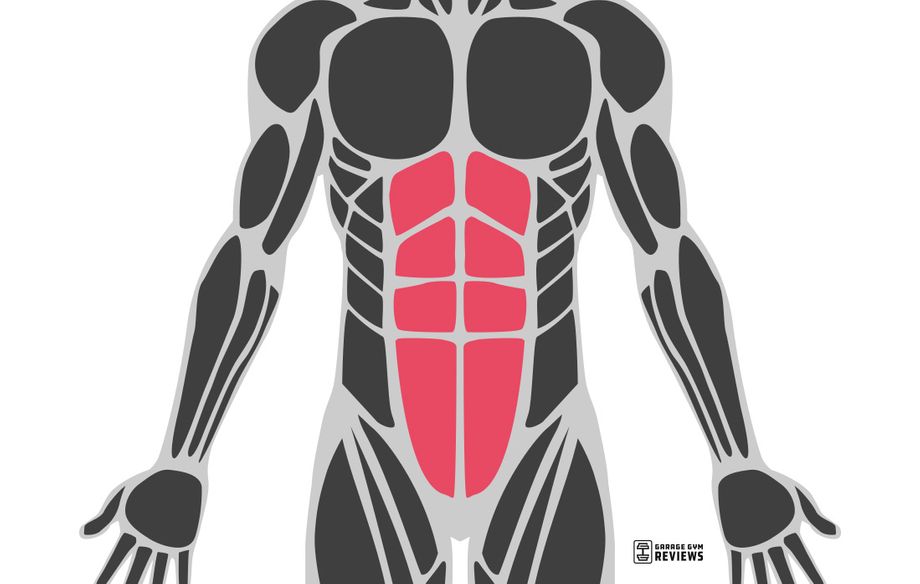
Practice Engaging Your Core
At a glance, the dead bug exercise involves simply extending the opposite arm and opposite leg at the same time, but the exercise loses its impact if you’re just going through the motions.
To really maximize the effect of the exercise on your overall core training, engage your core throughout the full movement. A great way to make sure you’re doing that is by taking a deep breath as you extend your arm and leg, then exhaling as you move to return to the starting position.
“Sync your breath with your movement,” says Capritto, “and never hold your breath.”
Look at the Ceiling
It’s tempting to look down at your legs while doing the dead bug, but doing so places strain on your neck. At best, you’ll walk away feeling a bit stiff and sore, but, at worst, it could contribute to a nasty, possibly permanent neck injury that limits your physical abilities.
Instead, stare straight up the ceiling and keep those eyes fixed there. Staring dead ahead ensures your neck maintains neutral positioning, encouraging proper spinal alignment and minimizing your risk of injury during the exercise.
Common Dead Bug Mistakes
The dead bug is an unassuming exercise that often requires nothing more than your own bodyweight to perform correctly, but that doesn’t mean you’re impervious to making a mistake.
Here are some of the most common mistakes when performing the dead bug exercise.
Spine Overextending/Arching
When you first get into the dead bug position, it’s easy to remember to push your lower back into the mat and brace the core. As you rack up the reps, however, and that position becomes excruciating to hold, it’s then easy to lose core tension and start arching the back and overextending the spine to compensate.
Not only does arching reduce the overall effectiveness of the exercise, it could contribute to a back injury including strains, sprains, and herniations.
We know it’s a challenging movement, but try to take a beat in between each rep and ensure you’re maintaining proper form and alignment. If you do feel yourself losing that perfect flat back positioning, finish the reps you’re on and rest.
Form first. Always.
Craning the Neck
Craning your neck is another great way to lose proper spinal alignment and place undue stress on critical regions of your body.
The dead bug exercise is supposed to strengthen your core, support your spine, relieve low back pain, and provide an overall positive impact on your health and well-being. A stiff neck is certainly not conducive to that goal.
Stare straight up at the ceiling during the dead bug exercise to ensure proper alignment and prevent possible injury to your neck.
RELATED: The Best Lower Back Exercises
Dead Bug Variations
Once you’ve mastered the standard dead bug movement, you can kick things up a notch using a number of dead bug variations. Here are two that will increase the challenge and, in turn, increase the effect of the exercise too!
Weighted Dead Bug
The dead bug requires no equipment to perform, but that doesn’t mean you can’t use equipment if you have some on hand. For example, adding one of the best dumbbells into the mix increases the resistance and therefore increases the activation in the target muscles.
To perform the weighted dead bug variation, simply follow the steps for the standard version while holding a dumbbell in each hand or a plate overhead.
We recommend going light to start because adding a free weight into the dead bug exercise creates a new challenge to your balance and stability. It’ll be much easier to navigate the movement, manage the challenge, and ultimately succeed using lighter dumbbells than it will by going heavy right out the gate.
Plus, your arms remain fully extended throughout the movement so, if exercises like front raises and chest flyes have taught us anything, the weights will feel heavier since they’re held far from the body.
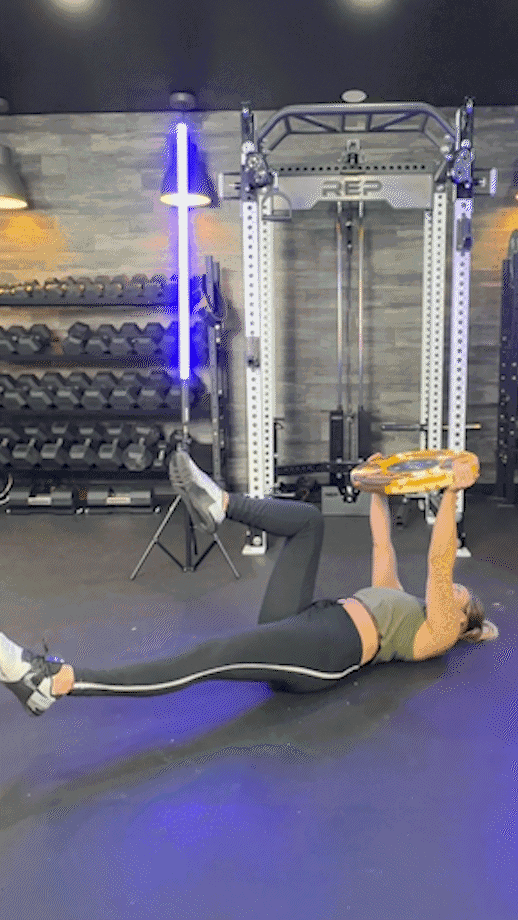
Pause Dead Bug
Are you familiar with tempo training?
Tempo training involves slowing down either the concentric or eccentric phase of the exercise. It can also involve pausing, as is the case with the pause dead bug.
Rather than simply getting in your reps of the dead bug exercise, the pause variation involves, well, pausing at the bottom of the movement with one arm and one leg fully extended above and below you respectively.
Now, you’re getting eccentric contraction as you lengthen your leg and core muscles, create an isometric contraction during the pause, and finish with a concentric contraction as the muscles are shortened again.
According to a 2022 review published in Healthcare (Basel)4, “isometric contractions may, indeed, be more useful for improving muscles than eccentric contractions and flexibility,” as “isometric training increases strength and the muscles’ ability to produce power.”
For this reason, incorporating a pause following the eccentric phase of the dead bug exercise will create an isometric contraction that, in turn, should enhance your results.
Useful Dead Bug Equipment Accessories
Minimalists love the dead bug exercise because it requires virtually no equipment. All you need is yourself, a floor, and you’re good to go!
That doesn’t mean you can’t add in a few fitness accessories to enhance the experience and make things more comfortable or more manageable.
Here are a few useful equipment accessories you can use during the dead bug exercise.
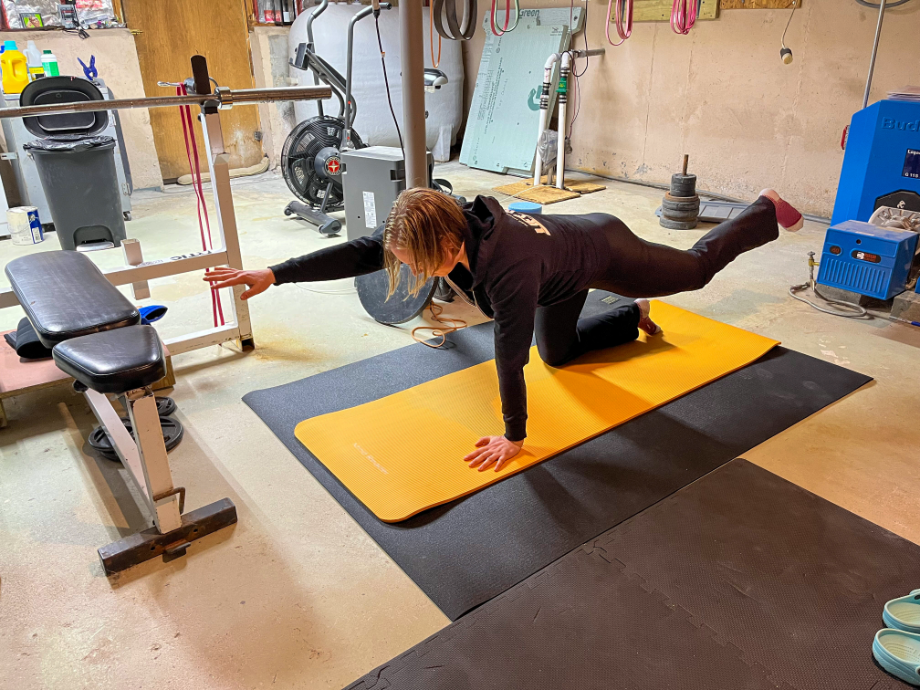
Yoga Mat or Exercise Mat
We know the dead bug exercise is going to hurt, but it should hurt because of the intense core activation, not the hard gym floor on your lower back.
An easy and inexpensive way to increase your comfort is by investing in a cushy yoga mat or one of the best exercise mats. Adding this accessory into the mix does not change how the exercise is done whatsoever, but it will help you stay focused on the exercise rather than your poor, poor back!
Yoga Block
Another inexpensive accessory that can be used during the dead bug exercise is the yoga block. Traditionally used to reduce the range of motion on yoga poses when your flexibility isn’t quite there yet, you can use a yoga block a number of different ways for the dead bug.
The most common way to incorporate a yoga block into the exercise is by squeezing it between your arm and the leg on the opposite side as you move. To clarify, if you’re doing a rep involving your left arm and right leg, you would wedge the block in between your right arm and left knee.
By squeezing the block between your arm and leg as the other limbs move, you maintain a perfect tabletop position with your left shin and encourage proper alignment throughout the motion.
It’s good because your limbs won’t drift away as you move, but you will no longer be able to alternate sides without repositioning the block every time.
A yoga block is also useful for tapping the feet if the floor is too hard to reach.
FAQs: Dead Bug Exercise
What does the dead bug exercise work?
The dead bug is an incredible core exercise that provides activation in numerous muscles and muscle groups, including:
Rectus abdominis: This is the “six-pack” muscle most people spend countless hours trying to develop. It’s an aesthetic focal point for many individuals, but its actual function is flexing your trunk and bringing your ribs towards your hips.
Transverse abdominis: A deep muscle that wraps around your abdomen like a corset, the transverse abdominis stabilizes your spine and pelvis, also supporting your organs.
Obliques: These muscles, including the internal and external obliques, run alongside the abdomen and assist in trunk rotation. According to a 2017 study published in the Journal of Manipulative and Physiological Therapeutics1, the “dead bug [creates] more activation of the oblique” due to the focus on working opposite sides simultaneously.
Hip flexors: These muscles, as the name suggests, flex your hips and help you bring your legs towards your torso, which is required for getting into the dead bug position.
Lower back muscles: While you’ll receive most activation in the front of your trunk, back muscles like the erector spinae get some activation during the dead bug exercise as well.
Because the exercise provides activation in various regions, the dead bug can be used to build core stability and strength, provide back support that prevents and reduces low back pain, and improves flexibility and mobility.
It’s a useful exercise for both athletes and everyday fitness enthusiasts.
RELATED: Lower Ab Workouts
Are dead bugs good for beginners?
Dead bugs are challenging, but they can be performed properly by beginners provided they practice and prioritize good form and work with a qualified personal trainer for safety purposes.
Once you’ve learned the ropes, it’s a non-impact exercise that deserves a permanent spot in your regular ab workout routine. Of course, make sure you perform a good warm-up featuring calisthenics or similar movements, like the bird dog, before diving in!
Can I do dead bug exercise every day?
Targeting the same muscle groups repeatedly for strength training is generally ill-advised, so doing dead bugs everyday and/or hitting your core everyday is likely a recipe for overtraining.
Allow approximately two days between training sessions so your muscles can fully recover before doing dead bugs and other ab exercises again. When in doubt, consult a qualified fitness professional or physical therapist to determine what will work best for you, your abilities, and your personal goals.
References
1. Pereira ILR, Queiroz B, Loss J, Amorim C, Sacco ICN. Trunk Muscle EMG During Intermediate Pilates Mat Exercises in Beginner Healthy and Chronic Low Back Pain Individuals. J Manipulative Physiol Ther. 2017;40(5):350-357. doi:10.1016/j.jmpt.2017.02.010
2. Fernández-Rodríguez R, Álvarez-Bueno C, Cavero-Redondo I, et al. Best Exercise Options for Reducing Pain and Disability in Adults With Chronic Low Back Pain: Pilates, Strength, Core-Based, and Mind-Body. A Network Meta-analysis. J Orthop Sports Phys Ther. 2022;52(8):505-521. doi:10.2519/jospt.2022.10671
3. GBD 2017 Disease and Injury Incidence and Prevalence Collaborators. Global, regional, and national incidence, prevalence, and years lived with disability for 354 diseases and injuries for 195 countries and territories, 1990–2017: a systematic analysis for the Global Burden of Disease Study 2017. The Lancet. 8 Nov 2018: 392.
4. Widodo AF, Tien CW, Chen CW, Lai SC. Isotonic and Isometric Exercise Interventions Improve the Hamstring Muscles’ Strength and Flexibility: A Narrative Review. Healthcare (Basel). 2022;10(5):811. Published 2022 Apr 27. doi:10.3390/healthcare10050811
Further reading

These 6 exercises will give you an effective upper body workout at home. Read more

It’s funny how a lot of movements we mastered as children, like squatting, lunge exercises, crawling, and jumping, to name a few, make such great exercises.Take the dead bug exercise for example. Simply lying on your back with your legs in the air like, well, a dead bug, provides a variety of benefits. You’ll receive great activation to your core1, including abdominal muscles like the rectus abdominis, » Read more about: The Dead Bug Exercise: A Valuable Tool for Core Strength and Stability » Read more

Rowing may not be as popular as running or cycling, but there are quite a few rowing machine benefits to convince you to hop on an erg. Slug: rowing-machine-benefits Read more

Budget is not always synonymous with quality. But in our guide to the best budget rowing machines, you’ll find that our picks are the exceptions. Read more

